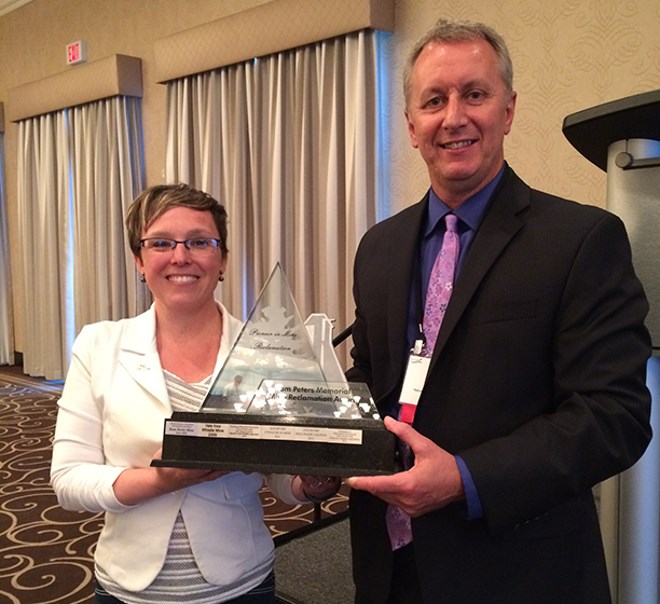Agnico Eagle's rehabilitation work of the Coniagas No. 4 shaft in Cobalt, Ont. took top honours at the 2017 Ontario Land Reclamation and Rehabitation Symposium held at the University of Guelph, June 26-28.
The event is dedicated to promoting excellence in the process of restoring land that has been mined back to a natural state or repurposing it for other uses.
An importance feature of the event is recognition of the winners of the annual Tom Peters Memorial Mine Reclamation Awards. The industry award recognizes outstanding achievement in the field of land reclamation.
Agnico Eagle's challenging assignment involved rehabilitating a decades-old mine shaft inside a historical building within the Town of Cobalt that currently hosts a bookstore and a suite of apartments.
The opening of the Coniagas Mine No. 4 shaft is under the main level floor inside the historical building and was originally closed with a steel-reinforced bulkhead and concrete cap in the mid-1980s.
A 2013 assessment revealed a small opening that had been left through the bulkhead.
Work needed to be done to complete rehabilitation and to secure the opening to surface without removing or damaging the historical building on top.
Agnico Eagle’s mining reclamation team worked with outside experts and the Ontario Ministry of Northern Development and Mines in 2015 to design and install a new and effective rehabilitation technique.
First, they sprayed a polyurethane foam plug to act as a platform to limit the next two layers of concrete from going down to deeper portions of the shaft.
Then, they installed the two-layered self-supporting cemented backfill which met the Ontario Mining Act’s requirements for rehabilitating mine openings to surface.
“This new technique has allowed us to preserve the heritage of the Coniagas Mine No. 4 headframe," said Agnico Eagle project leader Josée Noël in accepting the award.
"A site that in many ways also represents the birthplace of Agnico Eagle 60 years ago, and which demonstrates that we are still committed to leaving a positive legacy in the community."
Bryan Tisch, vice-president of the Ontario chapter of the Canadian Land Reclamation Association, said the winning project was outside conventional reclamation projects because it focused on the safe rehabilitation of physical structures rather than biological reclamation.
"The project showcases innovative rehabilitation techniques to safely restrict access to underground infrastructure, and to do so by preserving the heritage value associated with a headframe.
Developed in close collaboration with the Ministry of Northern Development and Mines, the Cobalt Historical Society, the private owners of the building, and the community, the project is considered a success in terms of sustainable development, addressing health and safety, environmental and social concerns.
The association and the Ontario Mining Association, together with Vale, presented a $5,000 student award to Jillian Bieser, who is completing her PhD at the University of Toronto.
Her work is focused on the development of sustainable soil amendments for use in mine tailing reclamation. Specifically, she is investigating the use of biochar, or wood-derived charcoal for use in mine remediation in Northern Ontario's boreal forest zone.
The study revealed that applying biochar significantly increased native plant growth and enhance the nutrients in the soil to better absorb heavy metals.




